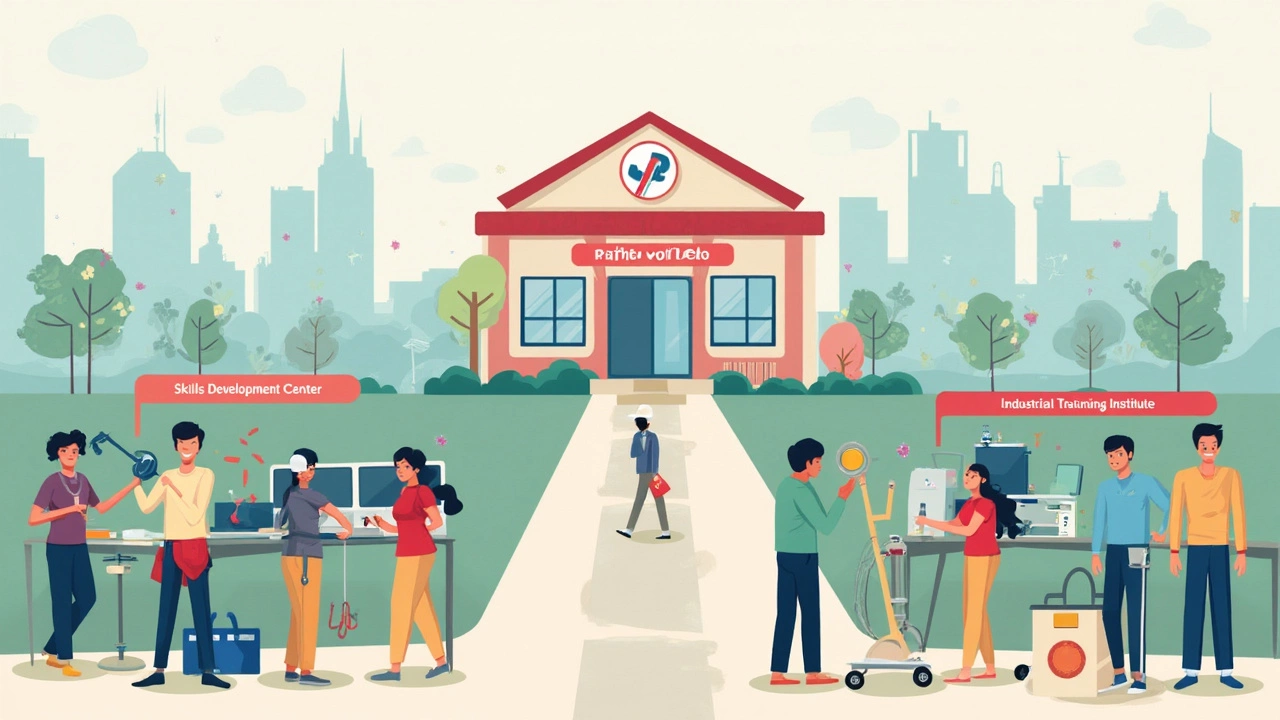
Ever heard people call it a "trade school" and wondered if it’s the same as a vocational school? You’re not alone. The world of career training is littered with different terms, and it can be pretty confusing if you aren’t already familiar with the lingo. Some folks say vocational school, others drop “technical college,” but they often mean places that teach you hands-on skills. The names might shift, but the goal stays the same: get you job-ready, fast and practical.
Let’s face it, not everyone wants to slog through four years of theory-heavy college. Maybe you want to fix cars, become a welder, or dig into healthcare—all without mountains of debt. That’s where vocational schools (or whatever you want to call them) shine. They’re focused on real-world skills, with programs designed so you can hit the ground running in the workforce. If you’re hunting for a path that skips the endless essays and lectures, you’re in the right spot to learn what these schools are actually called—and what they can do for you.
- What Is a Vocational School?
- Popular Alternative Names
- Why Different Names Matter
- Choosing the Right Program
- Using Your Skills in the Real World
What Is a Vocational School?
A vocational school is pretty straightforward—it’s a place where you go to learn the actual hands-on skills you’ll use in a job. Instead of focusing on traditional academic subjects, these schools zero in on practical training. You might hear them called trade schools, technical schools, or even career colleges, but the main point is always job skills you’ll actually use.
These schools cover a huge range of fields—think auto repair, plumbing, carpentry, medical assisting, dental hygiene, cooking, or information technology. If you’ve ever met someone who’s a certified electrician or an HVAC technician, chances are they went through a vocational program.
Most programs are quick compared to a typical four-year college. You’re looking at anywhere from a few months up to two years, depending on the program and the certification you need. Classes are practical—lots of workshops, labs, and hands-on practice, which means you’ll spend more time using actual tools or equipment than sitting in a lecture hall.
Vocational schools team up with companies and local industries to make sure what they teach matches what businesses are hiring for. This means if you finish, you’re not just book-smart—you can walk onto a job site and actually know what you’re doing. It’s super common for students to get certifications or licenses as part of finishing the program, which helps you find work faster once you’re done.
One cool thing? Older folks and recent high school grads both show up in these classrooms. Whether you want a first shot at a career or you’re making a switch, vocational schools are usually open to everyone. Most don’t even require you to take giant entrance exams, either.
Popular Alternative Names
If you’re poking around for places to learn skilled trades, you’ll run into a bunch of names. Vocational school is just the start. The other big one you’ll hear is trade school. This one’s kind of the go-to term if you’re eyeing jobs like electrician, plumber, or auto mechanic. It’s straight to the point—learn a trade, get working.
Then there’s technical school and technical college. These usually lean a bit more on tech or science-heavy stuff—think computer networking, engineering tech, or certain healthcare jobs. But honestly, people sometimes use these names almost interchangeably with vocational or trade school, especially in the U.S.
You might also hear career college—that pops up in Canada and sometimes in the States, too. These schools focus solely on job-ready programs. And don’t forget about apprenticeship programs, which partner classroom time with real job places, though they aren’t always labeled as ‘schools.’
- Vocational school
- Trade school
- Technical school / Technical college
- Career college
- Apprenticeship program
Here’s how the U.S. Department of Education puts it:
Vocational and technical education programs, sometimes called career and technical education (CTE), are designed to prepare students directly for employment in skilled trades, applied sciences, and technical fields.
No matter which name you see, what matters is the hands-on, practical training they all deliver. So, don’t get tripped up by the label. Focus on what the school actually offers and how it fits your career goals.

Why Different Names Matter
Here’s the thing—a lot of people get stumped by all the different names for these schools. One might say "technical college," another throws out "trade school," and someone else calls it a "career institute." It’s all kind of a jumble, but there are good reasons for it. Not every training program is exactly the same. Some focus on specific skills, some cover a wider range, and the name often gives you a clue.
If you’re on the hunt for programs, knowing the difference can save you time and even money. For example, a vocational school may offer short-term certificates to get you job-ready in fields like plumbing or IT, while a technical college sometimes runs longer programs and might even offer associate degrees. Trade schools usually stick with hands-on careers—think electricians, mechanics, carpenters. Technical institutes might focus more on areas like computer tech or graphic design.
The names affect how employers view your education, too. Some companies look for grads from "accredited technical colleges" for specific jobs, especially if you want to move up or work for a big business. If you move between states, you might find that what you knew as a vocational school is called something totally different—so knowing the label matters for job searches and even applying for loans or financial aid.
Check out how these schools stack up in real life:
| School Name Used | Focus | Program Length |
|---|---|---|
| Vocational School | Skilled trades, basic healthcare | 6 months – 2 years |
| Technical College | Advanced technology, engineering | 1 – 2 years (Associate degree possible) |
| Trade School | Construction, auto repair, welding | 6 months – 2 years |
| Career College/Institute | Healthcare, business support, IT | 1 – 2 years |
If you’re researching, check school websites and talk to advisors—don’t just go by the name, dig into what’s really offered. Always make sure the school is accredited. That way your certificate means something, no matter which name is on the sign.
Choosing the Right Program
There’s no one-size-fits-all when it comes to picking a program at a vocational school. What you need comes down to your interests, your goals, and how fast you want to get into a new job. Some programs take just a few months, while others might last up to two years. Before you pick, think hard about what type of work you actually enjoy and what jobs are in demand near you. No sense in becoming an HVAC tech if there are barely any companies hiring in your town.
It helps to know that not all schools offer the same programs, and the quality can vary. Want to get the best bang for your buck? Check if the school is accredited by a recognized agency—this proves their training meets certain standards. Some trades, like nursing or electronics, may require specific certifications that you’ll need after graduation. Make sure your program actually sets you up to get those certificates.
- Ask about job placement rates. A good school should have data on how many students land jobs right after graduating.
- Visit the campus if you can. See what the labs, classes, and equipment look like.
- Talk to recent grads. Their stories can tell you what to expect and if employers actually respect that school’s diploma.
- Don’t forget about cost. Some programs offer financial aid or even partnerships with employers, which can lower your expenses.
Here’s a quick look at average program lengths and typical starting salaries for a few popular fields:
| Program | Typical Length | Average Starting Salary (US) |
|---|---|---|
| Automotive Technician | 12-18 months | $38,000 |
| Electrician | 1-2 years | $42,000 |
| Medical Assistant | 9-12 months | $37,000 |
| Welding | 6-18 months | $40,000 |
| Plumbing | 1-2 years | $41,000 |
Narrowing down your options should feel less overwhelming when you see the numbers. Look at local demand, future pay, and how long you’ll be in school. That way, you’re not just picking a program—you’re picking a job you’ll actually stick with.

Using Your Skills in the Real World
So what happens after you finish up at a vocational school? You actually jump straight into work. There’s no playing the waiting game. These programs are built for jobs that are hiring right now—think electricians, dental assistants, mechanics, HVAC techs, and a load of other hands-on roles that need people who know what they’re doing from day one.
According to the National Center for Education Statistics, over 85% of graduates from career-focused programs land jobs related to their studies within six months. That’s wild compared to the stats from most four-year colleges, where new grads often spend months searching and sometimes settle for jobs outside their field.
Here’s a quick look at what grads from different programs tend to earn, and how quickly they find work:
| Program | Average Starting Salary | Job Placement Rate |
|---|---|---|
| Electrician | $55,000 | 90% |
| Plumber | $54,000 | 89% |
| Medical Assistant | $38,000 | 86% |
| Automotive Technician | $48,000 | 83% |
| Welding | $47,000 | 85% |
Pretty solid, right? Most of these careers don’t just pay well—they also have clear paths to move up. For example, many electricians go on to run their own small businesses after a few years, and skilled welders can find work on everything from skyscrapers to movie sets.
If you want the best shot at putting your new skills to use quickly, keep these tips in mind:
- Look for schools with strong ties to local industries. The more connections they have, the more likely you are to get job offers before you even graduate.
- Take any chance you get to do internships or work placements—they're the best way to get your foot in the door.
- Stay in touch with your instructors and classmates. Networking matters, no matter what field you’re in.
- Stay updated on new certifications or specialties that can help you stand out—you can always add more tools to your belt later on.
The skills you get from a vocational program are real, tangible, and always in demand. You don’t leave with just a piece of paper—you leave with a job-ready toolbox that employers are actually looking for.




